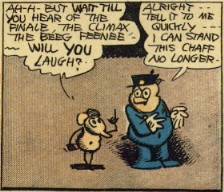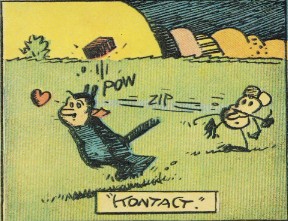George Herriman’s Krazy Kat has been, from the time I first encountered it as a teenager, among my favourite comics and remains so today. The pleasures of Krazy Kat—Herriman’s antic doodles, his constant innovations in background and layout, the exuberance of his dialogue, and the surpassing (arguably illimitable) richness of his characters—have been much celebrated by an array of fine writers ranging from Gilbert Seldes to e.e. cummings to Bill Watterson, but a few fresh points might be worth making.
 Firstly, if Herriman is, as he’s often called, the poet laureate of comics, then like the best poetry his work needs to be read slowly and in small doses. This is especially true of the full-page strips. Don’t race through a Krazy Kat collection as you would a graphic novel. Rather, take the time to savour the words and art. After you get to the bottom of the page, return to the top and start reading again. This process can be repeated many times with renewed pleasure.
Firstly, if Herriman is, as he’s often called, the poet laureate of comics, then like the best poetry his work needs to be read slowly and in small doses. This is especially true of the full-page strips. Don’t race through a Krazy Kat collection as you would a graphic novel. Rather, take the time to savour the words and art. After you get to the bottom of the page, return to the top and start reading again. This process can be repeated many times with renewed pleasure.
 Secondly, it is worth tracking Herriman’s changes: the earliest full-page strips from 1916 to the mid-1920s are dense reads, each one a little short story. During this period, the daily strips are quick jokes. Then there is a slow transition as the Sunday pages become quicker, while Herriman’s narrative interest shifts to the daily strip. This shift is quite evident by the mid-1930s when Herriman is allowed to have color on the full page. Each one becomes like a painting, while the dailies start featuring longer narratives, notably the famous “Tiger Tea” saga of the mid-1930s.
Secondly, it is worth tracking Herriman’s changes: the earliest full-page strips from 1916 to the mid-1920s are dense reads, each one a little short story. During this period, the daily strips are quick jokes. Then there is a slow transition as the Sunday pages become quicker, while Herriman’s narrative interest shifts to the daily strip. This shift is quite evident by the mid-1930s when Herriman is allowed to have color on the full page. Each one becomes like a painting, while the dailies start featuring longer narratives, notably the famous “Tiger Tea” saga of the mid-1930s.
 Thirdly and finally, Herriman was one of the very few cartoonists to express spiritual interest in his work. In many ways, the complexity of the love triangle is a critique of any easy use of terms like sin. And the repetition of the plot, day in and day out, is not unrelated to Herriman’s interest in reincarnation. To be fully tuned to Herriman’s special frequency we must have our spiritual receptivity open, as we do with a very few other cartoonists (such as Charles Schulz and Jim Woodring).
Thirdly and finally, Herriman was one of the very few cartoonists to express spiritual interest in his work. In many ways, the complexity of the love triangle is a critique of any easy use of terms like sin. And the repetition of the plot, day in and day out, is not unrelated to Herriman’s interest in reincarnation. To be fully tuned to Herriman’s special frequency we must have our spiritual receptivity open, as we do with a very few other cartoonists (such as Charles Schulz and Jim Woodring).
This article is a revised version of an essay that was originally published in the benefit anthology Favorites.
Jeet Heer is a Toronto-based editor and journalist. He is the co-editor, with Kent Worcester, of A Comics Studies Reader and Arguing Comics: Literary Masters on a Popular Medium. With Chris Ware and Chris Oliveros, he is co-editing the Walt & Skeezix reprint collections of Frank King’s Gasoline Alley newspaper strip. Four volumes have been published to date. His articles on the arts and culture have appeared in the Toronto Globe & Mail, the Boston Globe, and many other publications. He has previously written on Krazy Kat in his introductions to the Krazy & Ignatz reprint collections for the years 1935-1936 and 1939-1940.
NOTES
Krazy Kat, by George Herriman, received 46 votes.
The poll participants who included it in their top-ten lists are: Max Andersson, Derik Badman, Alex Buchet, Jeffrey Chapman, Brian Codagnone, Dave Coverly, Warren Craghead, Corey Creekmur, Francis DiMenno, Paul Dwyer, Austin English, Jackie Estrada, Andrew Farago, Larry Feign, Richard Gehr, Larry Gonick, Jenny Gonzalez-Blitz, Geoff Grogan, Jeet Heer, Sam Henderson, Illogical Volume, Bill Kartalopoulos, Molly Kiely, T. J. Kirsch, Carol Lay, Matt Madden, Chris Mautner, Joe McCulloch, Jason Michelitch, Gary Spencer Millidge, Pedro Moura, Mark Newgarden, Jason Overby, John Porcellino, Oliver Ristau, Matt Seneca, Mahendra Singh, Kenneth Smith, Matteo Stefanelli, Tom Stiglich, Tucker Stone, Mark Tonra, Mack White, Karl Wills, Matthias Wivel, and Douglas Wolk.
Matt Madden specifically voted for the works of George Herriman.
George Herriman’s Krazy Kat was a daily newspaper strip that began publishing October 28, 1913. The final strip was published June 25, 1944, two months after Herriman’s death on April 25.
As the strip is in the public domain, there have been many book collections published over the years. A complete, chronological 13-volume collection, titled Krazy & Ignatz, is currently in print.
For those looking for a reasonably priced one-volume introduction to the strip, the best choice is probably Krazy Kat: The Comic Art of George Herriman, by Patrick McDonnell, Georgia Riley de Havenon, and Karen O’Connell. A hardcover edition retails for $18.00 on the Barnes & Noble website. Click here to go to its product page. One can also find it in many public libraries.
–Robert Stanley Martin


Jeet, I think that’s an excellent selection, reading Krazy Kat not as one would read a graphic novel but as one would read poetry. The comparison is totally apt: the density, the lyricism, the play with space on the page. I want to go back and revisit KK right now, but my books are all in my office. :(
One effect of this poll is that I find myself wanting to get complete collections of these strips. I’d love to have a more complete Calvin & Hobbes, Krazy Kat, Little Nemo collection (and lets just throw in The Spirit and a couple others, just for fun). Hello, Amazon!
Jeff, the two hardcover Krazy Kat books from Fantagraphics are a great way to go. I just got them in the mail last week and they are beautiful. (Supposedly, the third and final one is coming later this year, to finish collecting all the Sundays.)
http://www.youtube.com/watch?v=zJ_piEWzJVg&feature=related
Krazy Kat: so routinely selected as “great” and “greatest” that its very name inspires yawns. But the work defies the tedium of repetition. Every critic has a different way to read it. Personally, I love the spacial relationships. And internal visual design sense.